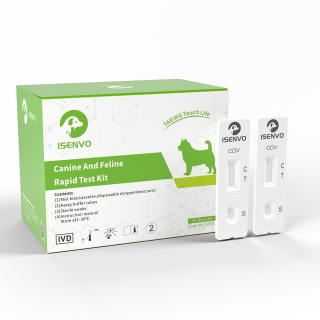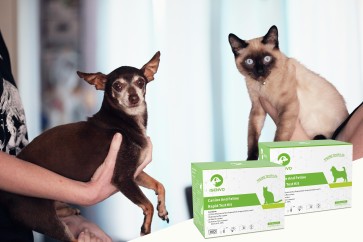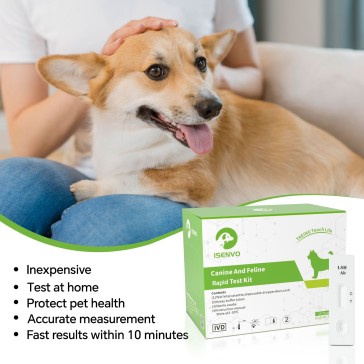Canine Distemper Virus (CDV) is a highly contagious and often fatal viral disease that primarily affects canines (dogs, foxes, wolves, etc.), especially puppies and unvaccinated dogs. Without timely intervention, the mortality rate can exceed 50%. Early diagnosis is crucial for improving survival rates, and the Taeing CDV Rapid Test Kit (Canine Distemper Virus Rapid Test Kit) can provide accurate results within 10 minutes, helping pet owners and veterinarians take immediate action.
1. Symptoms of Canine Distemper (CDV)
CDV infection presents with diverse symptoms that are often mistaken for common cold or gastroenteritis in early stages:
Early Symptoms (after 3-6 day incubation period)
-
High fever (above 40°C)
-
Ocular/nasal discharge (purulent)
-
Coughing, sneezing
-
Loss of appetite, lethargy
Mid-stage Symptoms (after virus spreads)
-
Vomiting, diarrhea (possibly bloody)
-
Hardening of footpads (hyperkeratosis)
-
Conjunctivitis, corneal ulcers
Late-stage Symptoms (neurological damage)
-
Convulsions, muscle tremors
-
Circling behavior, loss of balance
-
Paralysis, coma
⚠️ Important: Once neurological symptoms appear, the cure rate drops significantly, making early detection critical!
2. How is CDV Transmitted?
The canine distemper virus spreads through:
✅ Direct contact: Saliva, ocular/nasal discharge, urine, feces of infected dogs
✅ Airborne transmission: Coughing/sneezing droplets
✅ Indirect contact: Contaminated bowls, toys, clothing, etc.
The virus can survive in the environment for weeks to months, making unvaccinated dogs highly susceptible, especially:
-
3-6 month old puppies (after maternal antibodies wane)
-
Immunocompromised dogs (seniors, sick dogs)
-
Unvaccinated or incompletely vaccinated dogs
3. How to Quickly Diagnose CDV? Taeing CDV Rapid Test Kit
Traditional CDV diagnosis relies on PCR testing (requires lab, takes 1-2 days), while the Taeing CDV Rapid Test Kit (Canine Distemper Virus Rapid Test Kit) provides results in 10 minutes, suitable for both home and clinical use.
Testing Principle
Uses immunochromatography to detect CDV antigen in ocular/nasal discharge, saliva, or blood samples.
Procedure
-
Collect sample: Swab ocular/nasal discharge or saliva
-
Add buffer solution: Mix sample with reagent
-
Read results: After 10 minutes (similar to COVID antigen test)
-
C line + T line = Positive (CDV infection)
-
C line only = Negative
-
No lines or T line only = Invalid (retest needed)
-
✅ Advantages of Taeing CDV Test Kit
✔ Fast (results in 10 minutes)
✔ Accurate (>95% sensitivity, high concordance with PCR)
✔ Easy to use (no special equipment required, suitable for home use)
✔ Cost-effective (more affordable than lab testing)
4. CDV Treatment Options
There is no specific antiviral treatment - management focuses on:
Fluid therapy (prevent dehydration)
Antibiotics (prevent secondary infections)
Immunostimulants (e.g., interferon)
Antiemetics/antidiarrheals (symptom control)
Neurological symptom management (e.g., anticonvulsants)
⚠️ Key Points:
-
Earlier treatment = higher survival rate (up to 70% for early cases)
-
Immediately isolate infected dogs after positive test to prevent spread
5. CDV Prevention Strategies
1. Vaccination (Most Effective!)
-
Core vaccine: First dose at 6-8 weeks, boost every 2-4 weeks until 16 weeks
-
Adult dogs: Annual or triennial boosters (depending on vaccine type)
2. Environmental Disinfection
-
Use bleach (1:30 dilution) or CDV-specific disinfectants
-
Thoroughly disinfect items contacted by infected dogs
3. Reduce Exposure Risk
-
Avoid taking unvaccinated dogs to pet stores, dog parks, stray dog areas
-
Test new dogs with Taeing CDV Rapid Test Kit before introduction
6. Conclusion: Early Detection, Early Treatment, Early Prevention!
CDV is one of the deadliest canine diseases, but risks can be greatly reduced through vaccination + rapid testing. The Taeing CDV Rapid Test Kit enables both homes and clinics to detect infections immediately for optimal treatment timing.
Recommended for all dog owners, especially multi-dog households and puppy owners!
⚠️ Disclaimer: This article is for informational purposes only. Consult a veterinarian for diagnosis and treatment if your dog shows suspicious symptoms.









